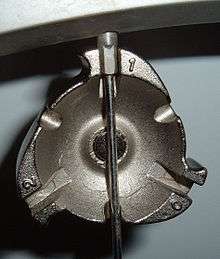Spoke wrench

A spoke wrench or spoke key is a small wrench or tool used to adjust the tension in the spokes of a bicycle wheel,[1][2] sulky wheel, wheelchair wheel, or similar wheel. A spoke wrench is sometimes called a nipple wrench, as it is the spoke nipple - not the spoke - that is turned in the process of changing the tension of a spoke.
Overview
Spoke nipples are typically T-shaped in cross section, with an internal thread running part of the way through the hole that runs along the spoke nipple's principal axis. A spoke nipple rests in a hole drilled radially through the wheel's rim, and the nipple is threaded onto the external thread of a spoke. The spoke itself is fixed, at its other end, through a hole in the hub. The spoke and nipple are functionally equivalent to a bolt and a nut. However, unlike a typical nut-and-bolt pair, a spoke and nipple do not join two parts (the rim and the hub) so much as bridge them, under tension.
The area of the nipple around which the spoke wrench, or key, is fitted in use is square in cross-section. Spoke keys may be 3- or 4-sided; the latter type has a small cutout to enable it to be fitted over a spoke, after which it may be slid along to engage all four flats of the nipple. It is less likely to round off the nipple than the 3-sided type, but is slower to use.
Sizes
| Spoke wire gauge | spoke size[4] | nipple size | usage | Park tools | Topeak tools |
|---|---|---|---|---|---|
| 14 or 15 | 2.0 mm (14g) or 1.8 mm (15g) | 3.23 mm (0.127 in) | DT Swiss, Sapim and Wheelsmith nipples | SW-0 | DuoSpoke 14G (3.4mm)/15G (3.2mm) |
| 14 | 2.0 mm | 3.30 mm (0.130 in) | most European | SW-1 | |
| 14 | 2.0 mm | 3.40 mm
(0.134 in) |
Shimano WH-R500/R501 series | DuoSpoke 14G (3.4mm)/15G (3.2mm) | |
| 13 | 2.3 mm | 3.45 mm (0.136 in) | most Asian | SW-2 | |
| 14 | 2.0 mm | 3.96 mm (0.156 in) | Shimano C50/C24/RS10/RS30 | SW-3 |
Use
A spoke wrench is used during the creation, maintenance, or repair of spoked wheels to adjust the tension of the spokes. The goal common to these activities is to bring the wheel (nearer) to a state of true — namely, a wheel in which the rim is 1) a perfect circle concentric with the axis of the axle in the hub, and 2) planar, such that the plane of the rim is centered laterally between the two extremes of the axle where it is supported in a frame. Additionally it is to make the spoke tension as close to the same on all spokes on the same side of the wheel, and to center the rim between the locknuts of the hub (known as dishing the wheel).
By increasing or decreasing the tension of individual spokes, or groups of spokes, around the circumference, a wheelsmith can correct for local deviations from true - e.g. wobbles, or hops.
Gallery
Various types of spoke wrenches
References
- ↑ Greg Kopecky (Apr 5, 2013). "Wheel Truing How-To". Slowtwitch.com. Retrieved 2013-12-29.
You will also need a spoke wrench.
- ↑ Sheldon Brown. "Wheelbuilding". Retrieved 2013-12-29.
You will need a spoke wrench.
- ↑ "MultiSpoke Wrench". Topeak inc.
- ↑ Sheldon Brown. "Wheelbuilding - Spoke Gauges".
- Brandt, Jobst; The Bicycle Wheel
| The Wikibook Bicycles has a page on the topic of: Truing a bicycle wheel |


